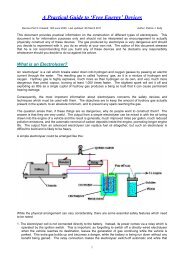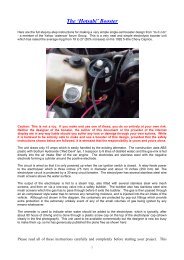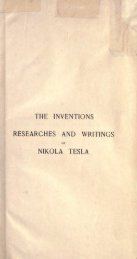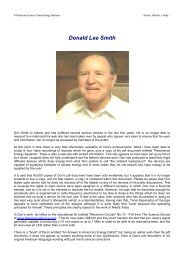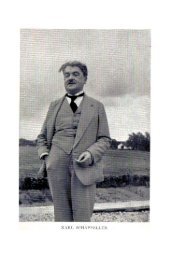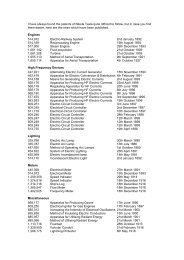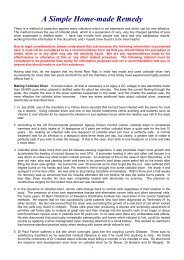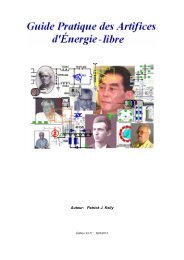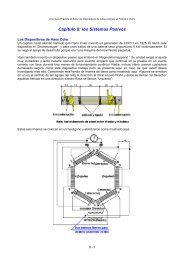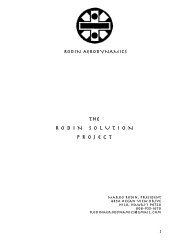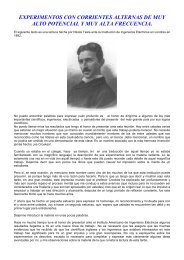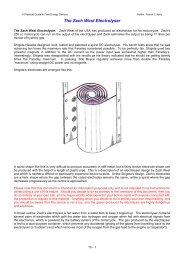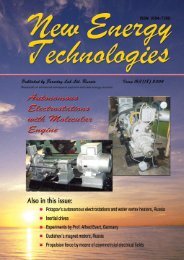A Practical Guide to 'Free-Energy' Devices
A Practical Guide to 'Free-Energy' Devices
A Practical Guide to 'Free-Energy' Devices
You also want an ePaper? Increase the reach of your titles
YUMPU automatically turns print PDFs into web optimized ePapers that Google loves.
12. The fluid-powered energy conversion device of claim 11 further comprising a cooling fan mounted on the drive<br />
shaft, said cooling fan directing cooling air through the genera<strong>to</strong>r.<br />
13. A wind-powered energy conversion device for converting wind energy in<strong>to</strong> mechanical energy, said device<br />
comprising: a rigid cylindrical frame having an upstream annular chamber, a downstream annular chamber, and<br />
an annular central divider between the upstream chamber and the downstream chamber, each of said chambers<br />
having sides that are open <strong>to</strong> allow entry of ambient wind, and said annular central divider having a central<br />
aperture therein and having a downstream surface that slopes downstream as it approaches a central longitudinal<br />
axis of the device; a first set of baffles longitudinally mounted in the upstream chamber and curved <strong>to</strong> form a<br />
<strong>to</strong>roidal pattern that operates <strong>to</strong> create in an upstream central vortex chamber cantered around a central<br />
longitudinal axis of the device, an upstream drive vortex rotating in a first direction when the ambient wind enters<br />
the upstream chamber through the upstream chamber's open sides and through openings between the baffles; a<br />
first set of hinged louvers positioned in the openings between the first set of baffles and encircling the upstream<br />
central vortex chamber, said first set of louvers being operable <strong>to</strong> permit entry of the wind in<strong>to</strong> the upstream<br />
central vortex chamber only when the wind is rotating in the first direction, and <strong>to</strong> prevent the wind from exiting the<br />
upstream central vortex chamber through the sides of the device; a second set of baffles longitudinally mounted in<br />
the downstream chamber and curved <strong>to</strong> form a <strong>to</strong>roidal pattern operable <strong>to</strong> create in a downstream central vortex<br />
chamber cantered around the central longitudinal axis of the device, a downstream extraction vortex rotating in a<br />
direction opposite <strong>to</strong> the first direction when the ambient wind enters the downstream chamber through the<br />
downstream chamber's open sides and through openings between the baffles; a second set of hinged louvers<br />
positioned in the openings between the second set of baffles and encircling the downstream central vortex<br />
chamber, said second set of louvers being operable <strong>to</strong> permit entry of the wind in<strong>to</strong> the downstream central vortex<br />
chamber only when the wind is rotating in the direction opposite <strong>to</strong> the first direction, and <strong>to</strong> prevent the wind from<br />
exiting the downstream central vortex chamber through the sides of the device; a floor of the upstream annular<br />
chamber that slopes downstream as the floor approaches a central longitudinal axis of the device, said floor<br />
causing the drive vortex <strong>to</strong> flow downstream and pass through the central aperture in the annular central divider; a<br />
longitudinal drive shaft centrally mounted in the central aperture; and a turbine mounted on the drive shaft in the<br />
central aperture, said turbine comprising a set of rotating blades, each of said blades having a cross-sectional<br />
shape of a curved airfoil that generates a lift force, said lift force being directed in the direction of rotation of the<br />
turbine, said turbine being rotated by the drive vortex as the drive vortex passes through the turbine and reverses<br />
direction <strong>to</strong> match the direction of the extraction vortex.<br />
14. The wind-powered energy conversion device of claim 13 further comprising a flywheel mounted on the drive<br />
shaft, said flywheel having sufficient mass <strong>to</strong> operate as an internal energy s<strong>to</strong>rage device due <strong>to</strong> its angular<br />
momentum.<br />
15. The wind-powered energy conversion device of claim 13 further comprising an electrical genera<strong>to</strong>r mounted<br />
on the drive shaft, said genera<strong>to</strong>r converting mechanical energy from the rotation of the shaft in<strong>to</strong> electrical<br />
energy.<br />
16. The wind-powered energy conversion device of claim 13 wherein the extraction vortex rotates in a countercyclonic<br />
direction so that the extraction vortex dissipates after it exits the downstream chamber.<br />
17. A wind-powered energy conversion device for converting high-speed wind energy in<strong>to</strong> mechanical energy,<br />
said device comprising: a rigid cylindrical frame having an upstream annular chamber and a downstream annular<br />
chamber, each of said chambers having sides that are open <strong>to</strong> allow entry of the high-speed wind; a first set of<br />
baffles longitudinally mounted in the upstream chamber that create in an upstream central vortex chamber, an<br />
upstream drive vortex rotating in a first direction when the high-speed wind enters the upstream chamber through<br />
the upstream chamber's open sides and through openings between the baffles; a first set of hinged louvers<br />
positioned in the openings between the first set of baffles and encircling the upstream central vortex chamber,<br />
said first set of louvers being operable <strong>to</strong> permit entry of the wind in<strong>to</strong> the upstream central vortex chamber only<br />
when the wind is rotating in the first direction, and <strong>to</strong> prevent the wind from exiting the upstream central vortex<br />
chamber through the sides of the device; a second set of baffles longitudinally mounted in the downstream<br />
chamber that create in a downstream central vortex chamber, a downstream extraction vortex rotating in the first<br />
direction when the high-speed wind enters the downstream chamber through the downstream chamber's open<br />
sides and through openings between the baffles; a second set of hinged louvers positioned in the openings<br />
between the second set of baffles and encircling the downstream central vortex chamber, said second set of<br />
louvers being operable <strong>to</strong> permit entry of the wind in<strong>to</strong> the downstream central vortex chamber only when the wind<br />
is rotating in the first direction, and <strong>to</strong> prevent the wind from exiting the downstream central vortex chamber<br />
through the sides of the device; a floor of the upstream annular chamber that slopes downstream as the floor<br />
approaches a central longitudinal axis of the device, said floor causing the drive vortex <strong>to</strong> flow downstream and<br />
pass through a central aperture located between the upstream annular chamber and the downstream annular<br />
chamber; a longitudinal drive shaft centrally mounted in the central aperture; and a turbine mounted on the drive<br />
A - 1250



